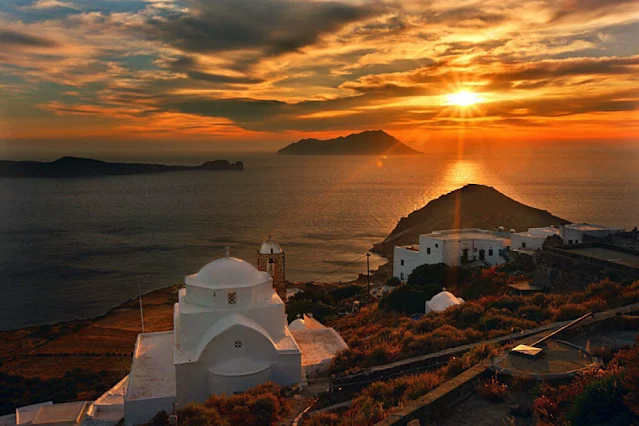The charming village of Plaka on the Greek island of Milos is not only a place of historic significance and cultural richness but also a place of breathtaking natural beauty.
As the sun begins its descent over the Aegean Sea, a nightly spectacle unfolds, offering travelers a mesmerizing view and a moment of serenity that lingers in memory long after the journey ends.
The Allure of Plaka:
Plaka, the island's capital, is perched on a hill, offering panoramic views of the surrounding landscape and the vast expanse of the sea. The village itself is a labyrinth of narrow winding streets, traditional whitewashed buildings, and charming squares adorned with colorful flowers. Visitors can stroll through these picturesque alleys, exploring quaint shops, cozy cafes, and welcoming tavernas that serve traditional Greek dishes.
The Calm Before the Sunset:
As the day turns to evening, the atmosphere in Plaka begins to change. The setting sun casts a warm, golden glow on the village, enhancing its enchanting beauty. The narrow streets come alive with the soft chatter of locals and the laughter of travelers, creating an inviting and friendly atmosphere.
The Journey to the Castle:
One of the most captivating spots in Plaka for watching the sunset is the Kastro, the village's medieval castle. Perched at the highest point in Plaka, the Kastro offers unobstructed views of the sea, making it an ideal spot for witnessing the daily spectacle.
To reach the Kastro, you'll need to follow the narrow paths that lead to the top of the hill. As you ascend, you'll pass charming homes, historic churches, and local shops. The ascent can be somewhat steep and may require comfortable walking shoes, but the effort is rewarded with an unforgettable view.
The Sunset Unveiled:
As you reach the Kastro and find a comfortable vantage point, you'll have a front-row seat to one of the most captivating sunsets in the Cyclades. The sky transforms into a canvas of colors, as shades of orange, pink, and purple blend harmoniously with the deep blue of the Aegean. The sun dips below the horizon, and the reflection on the water creates a mirror-like effect, making it seem as though the village is floating on a sea of gold.
A Moment of Reflection:
The beauty of the sunset at Plaka extends beyond its visual splendor. As the sun sets and the village begins to twinkle with the soft glow of streetlights, a moment of reflection washes over you. The simplicity and serenity of this experience, set against the backdrop of a centuries-old village, provide a sense of tranquility and connection to the natural world that is truly rejuvenating.
Practical Tips:
- Arrive at the Kastro a little earlier to secure a prime spot for viewing the sunset, as it can get crowded during peak tourist season.
- Don't forget to bring your camera or smartphone to capture this magical moment.
- Wear comfortable shoes for the uphill walk to the Kastro.
- After the sunset, explore Plaka's charming streets and enjoy a delicious Greek meal in one of the local tavernas.
In conclusion, the sunset at Plaka, Milos, is a captivating and spiritual experience that offers travelers a glimpse into the timeless beauty of the Cyclades. It's a moment that transcends the passage of time and leaves an indelible mark on the heart of those who are fortunate enough to witness it. As the sun sets over the Aegean, it leaves behind a tranquil village and a memory of serenity that stays with you long after you've left the enchanting island of Milos.

Comments
Post a Comment